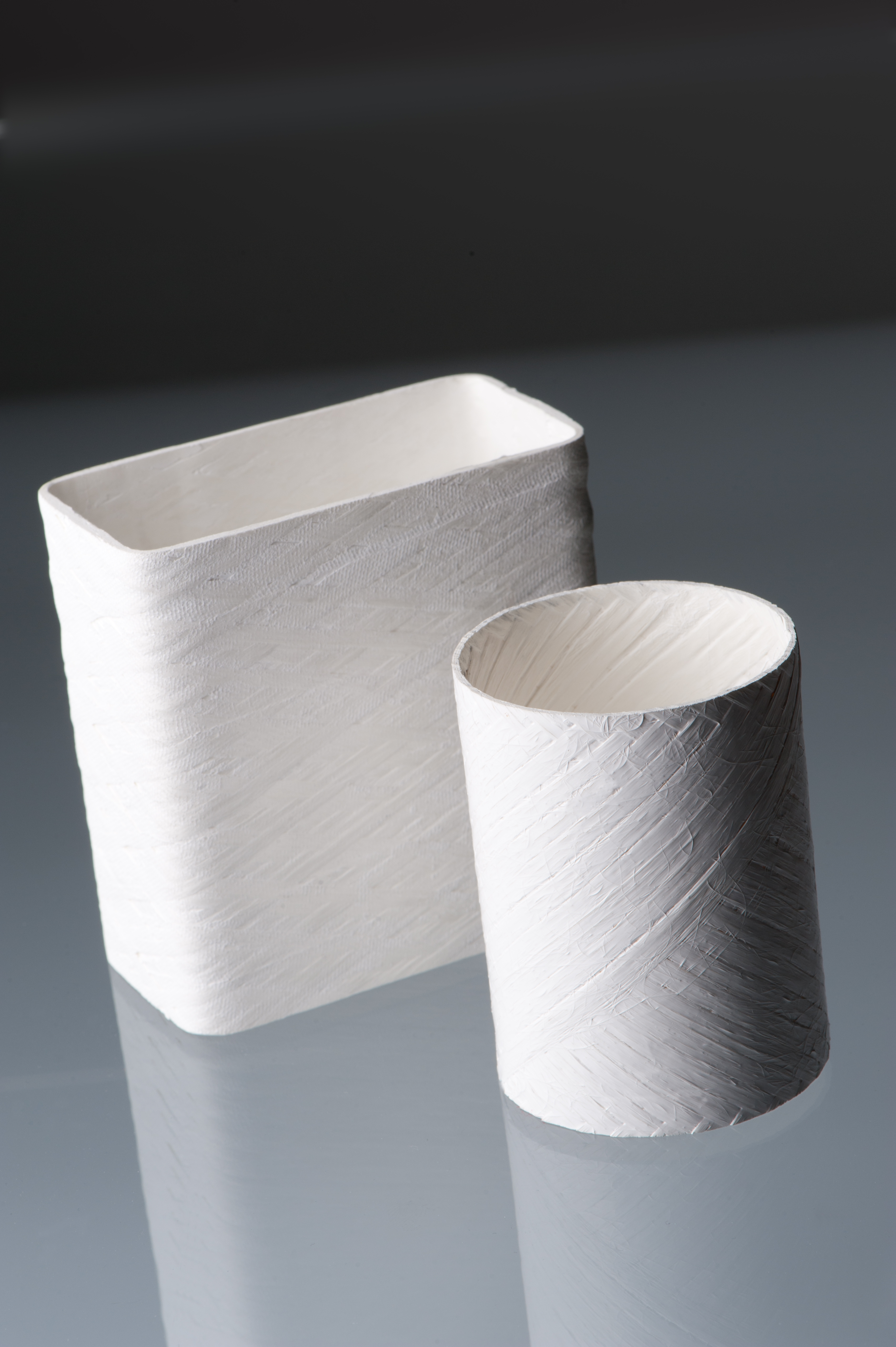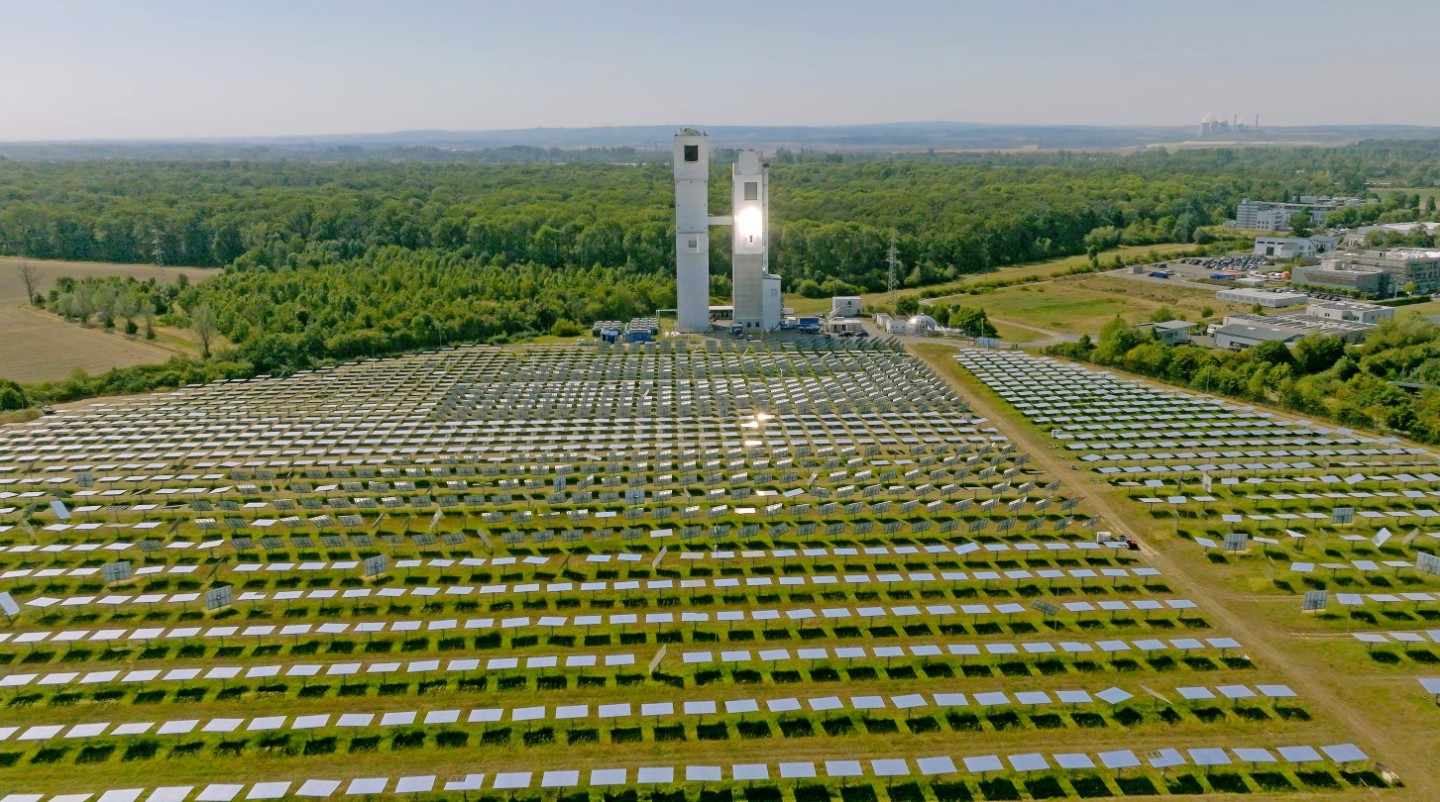When sunlight becomes fuel

Spinning of oxide-ceramic fibers on a pilot-plant scale.
© Fraunhofer HTL
Producing sustainable fuels from solar energy is an ambitious project and presents major challenges to people and material. In the MAfoS project, researchers at the Fraunhofer Center for High Temperature Materials and Design HTL are developing materials for the first industrial solar-to-fuel demonstration plant.
It sounds almost like a fairytale: Sustainable fuels are created from water, CO2 and sunlight in a high, mirror-lined tower. Fraunhofer experts are contributing their know-how to this plan in a special project:
“Material Advancements for Solar Fuels Technology,” or MAfoS for short, is the name of the project in which a team of creative scientists at the Center for High Temperature Materials and Design HTL of the Fraunhofer Institute for Silicate Research ISC are developing advanced materials for the first industrial solar-to-fuel demonstration plant. Together with their partners, the experts are working on a holistic concept for reducing CO2 and storing renewable energies in artificial fuels as part of the European funding program Eurostars 3.
A tower full of energy
In fact, a pilot plant already exists. It is operated by the project partner Synhelion, a Swiss start-up company, at the solar tower of the German Aerospace Center (DLR) in Jülich, Germany. In this solar-to-fuel plant, fuels are created from water and carbon dioxide or methane. The experts are currently focusing on kerosene. The plant encompasses a large area with mirrors that bundle sunlight. In a tower, the sunlight is converted into heat, which is conveyed via a pipe to a reactor chamber. There, the heated starting products react with each other and form the desired fuel.
 Aerial view of the solar tower and mirror field of DLR, Jülich. The mirror field concentrates the solar radiation onto the solar tower and heats up the solar receiver. © Synhelion
Aerial view of the solar tower and mirror field of DLR, Jülich. The mirror field concentrates the solar radiation onto the solar tower and heats up the solar receiver. © Synhelion
To start the process and use the tower for fuel production, special materials are required for the individual components. The high temperatures in combination with water vapor pose a challenge: At the sunlight entry window, the temperatures are still relatively moderate at up to 800 degrees Celsius. In the following process steps, the temperature increases to up to 1,500 degrees Celsius. Selecting material for these conditions is especially demanding, and the design solutions are complicated. New, extremely resistant high-performance coatings should make this easier in the future and provide more options for designers.
Material know-how for high-temperature materials
This is where Fraunhofer HTL comes in with its material expertise in lightweight construction and high-temperature materials. They develop inorganic ceramic materials as protective coatings for various plant components and future applications. The materials have to meet numerous requirements: For example, it is crucial for the coating on the entry window to be continuously permeable to sunlight and resistant to water vapor. In addition, the coating must be adapted to the thermal expansion coefficient of the glass pane, so that it does not flake off during temperature changes. With the following process stages and their continuously increasing temperatures, the coating must always be adapted to the corresponding carrier substrate for thermal expansion and be tight at the same time.


In addition to these materials, the Fraunhofer experts are also developing carrier structures made of fiber-reinforced ceramic for pipes. Fiber-reinforced ceramic is more damage-tolerant than monolithic ceramic, but the fibers available on the market only tolerate a maximum of 1,200 degrees Celsius. The scientists at Fraunhofer HTL have set themselves the goal of achieving a higher temperature stability and increasing the application temperature of the reinforcement fibers to 1,500 degrees Celsius.
Successful in cooperation
The researchers have already achieved an initial important milestone: the coating for the sunlight entry window. “The greatest challenge here was the very low coefficient of thermal expansion. However, we have been able to identify a suitable material. Our tests were able to prove that it is not only especially resistant to heat but also to water vapor. It protects the underlying material and is transparent enough to continuously allow enough sunlight to pass through,” says MAfoS project manager Jonathan Maier with satisfaction.
In the next step, the scientists want to coat the entry window in the actual component size, so that it can be tested at Synhelion. Together with CeraFib, a project partner specializing in high-temperature-resistant composite materials and components, the experts at Fraunhofer HTL have also successfully produced pipes made of fiber-reinforced ceramic.
The experts at Fraunhofer HTL are not only enthusiastic about the overall project but also about the contribution that they can make through their participation: “We have always wanted to enter the field of renewable energy, energy efficiency, power-to-X and power-to-fuel with our classic Fraunhofer HTL topics, i.e., high-temperature coatings and materials as well as ceramic fibers. In this project, we are proving that we are a strong cooperation partner in this area, even for small and medium-sized enterprises, because we are customer-oriented and close to the market with our technical know-how,” Arne Rüdinger, head of the Ceramic Fibers department at Fraunhofer HTL, is happy to report. And Jonathan Maier adds, “It is also great that our research is able to make such an important contribution to CO2 reduction and thus to the sustainable transformation of our society.” A transformation that will soon be in reach thanks to the commitment of the MAfoS partners: Synhelion’s industrial solar-to-fuel demonstration plant is already set to start operation in Germany in 2024.
Weitere Informationen:
https://www.fraunhofer.de/en/press/research-news/2024/february-2024/when-sunligh…
Media Contact
All latest news from the category: Power and Electrical Engineering
This topic covers issues related to energy generation, conversion, transportation and consumption and how the industry is addressing the challenge of energy efficiency in general.
innovations-report provides in-depth and informative reports and articles on subjects ranging from wind energy, fuel cell technology, solar energy, geothermal energy, petroleum, gas, nuclear engineering, alternative energy and energy efficiency to fusion, hydrogen and superconductor technologies.
Newest articles
Faster, more energy-efficient way to manufacture an industrially important chemical
Zirconium combined with silicon nitride enhances the conversion of propane — present in natural gas — needed to create in-demand plastic, polypropylene. Polypropylene is a common type of plastic found…

Energy planning in Ghana as a role model for the world
Improving the resilience of energy systems in the Global South. What criteria should we use to better plan for resilient energy systems? How do socio-economic, technical and climate change related…

Artificial blood vessels could improve heart bypass outcomes
Artificial blood vessels could improve heart bypass outcomes. 3D-printed blood vessels, which closely mimic the properties of human veins, could transform the treatment of cardiovascular diseases. Strong, flexible, gel-like tubes…
 Aerial view of the solar tower and mirror field of DLR, Jülich. The mirror field concentrates the solar radiation onto the solar tower and heats up the solar receiver. © Synhelion
Aerial view of the solar tower and mirror field of DLR, Jülich. The mirror field concentrates the solar radiation onto the solar tower and heats up the solar receiver. © Synhelion




















